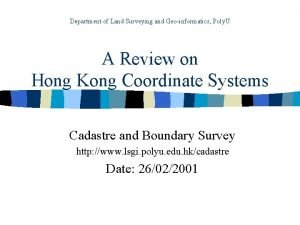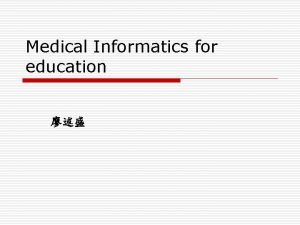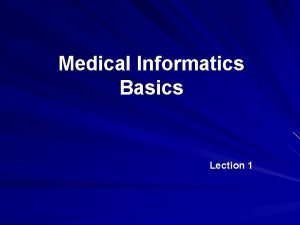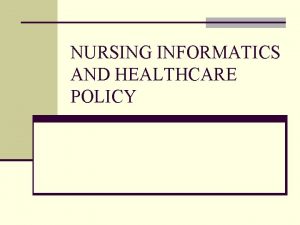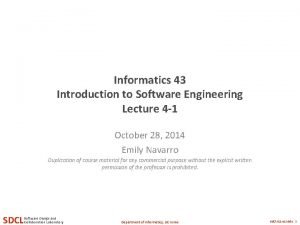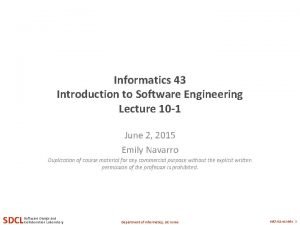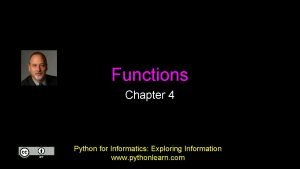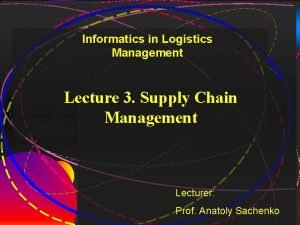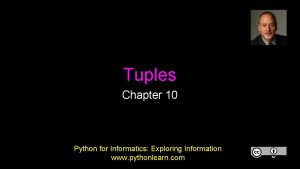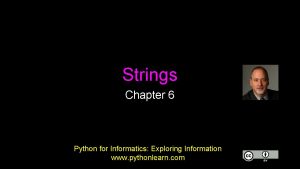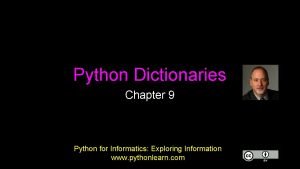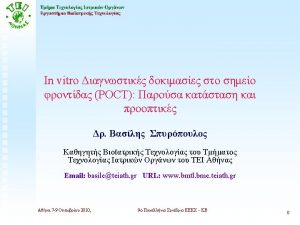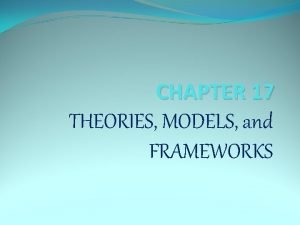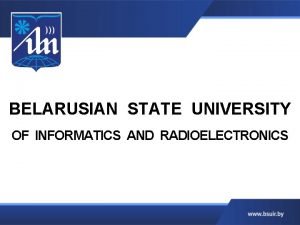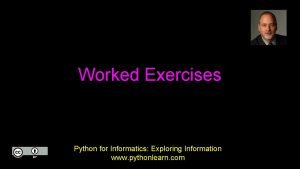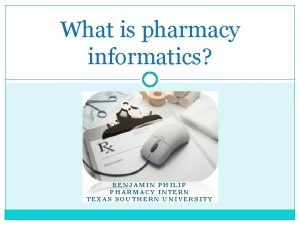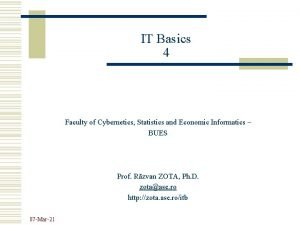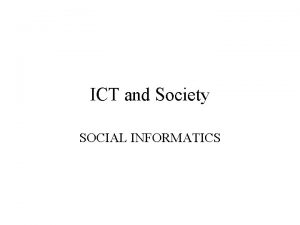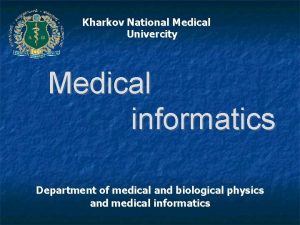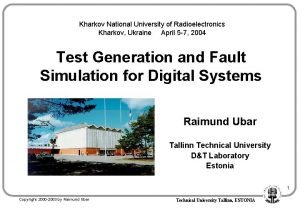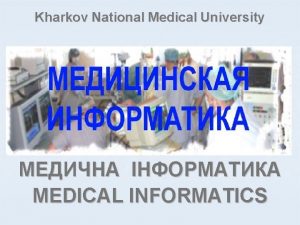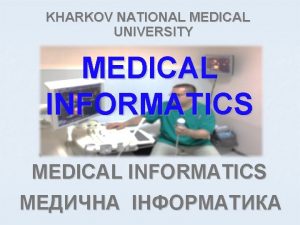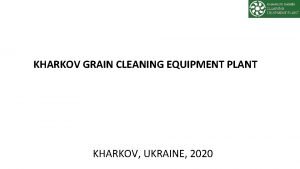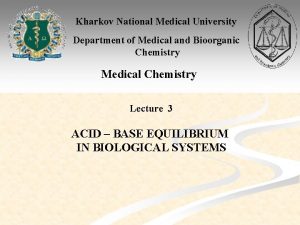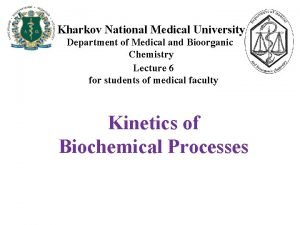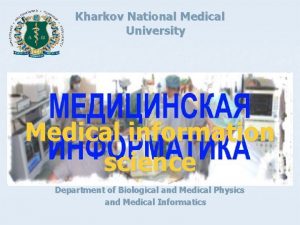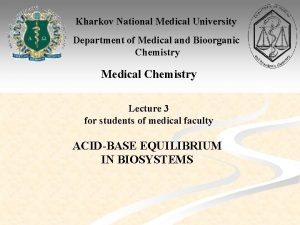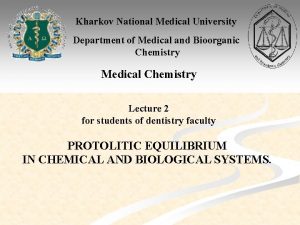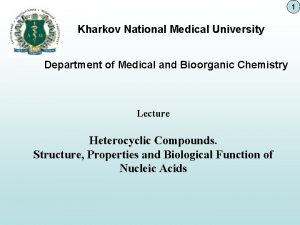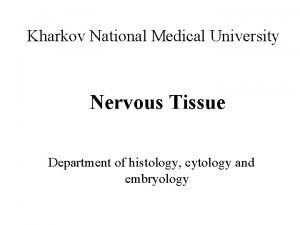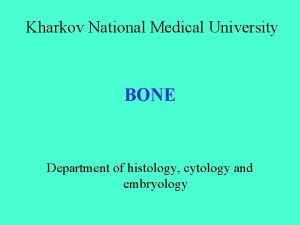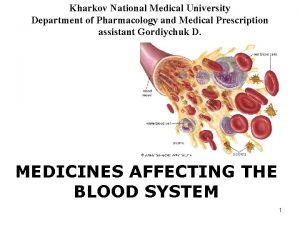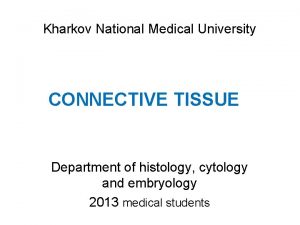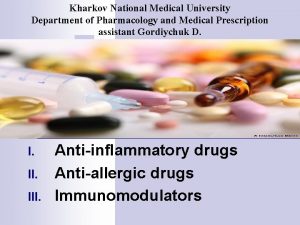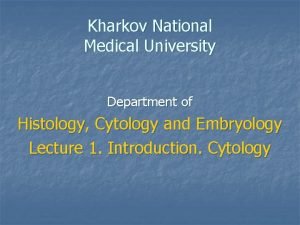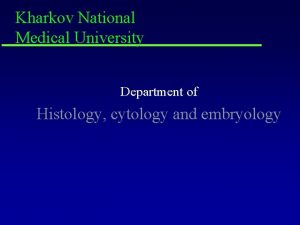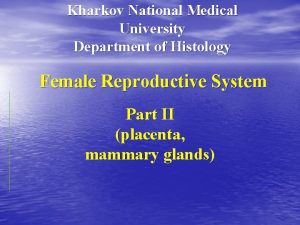Kharkov National Medical Univercity Medical informatics Department of


























- Slides: 26

Kharkov National Medical Univercity Medical informatics Department of medical and biological physics and medical informatics

Formal logic in solving problems of diagnostics, treatment and prevention diseases. Neural networks.

PLAN Knowledge and its presentation in artificial intelligence systems. Notion of “knowledge”. Types of knowledge, their properties. Knowledge presentation models. Logical models. Formal systems. Logic of proposition calculus. Neuron networks.

Artificial intellect Under the artificial intellect is understood the ability of automatic or automatized systems to take upon themselves functions of human’s intellect, for example, to make optimal decisions on the basis of analysis of external actions and taking into account the previous experience. Several trends where AIS are developed can be distinguished: expert systems, intellectual games, image recognition, robotics, communication with an electronic computer in the natural language.

The Knowledge The knowledge is data, complex in structure, stored in AIS memory, containing information about objects, their surrounding and relations between them, object interaction processes in time and space, rules of logical deduction realization. The main element of this definition is the evidence that knowledge is information on the basis of which the logical deduction is realized. The following types of knowledge can be distinguished: Factual and strategic knowledg e Declarative knowledge and procedure

Types of knowledge Characterize the sourse Of appearance Factual Strategic Characterize activity Declarative Procedure

Factual knowledge is called textual, bearing in mind its essential interpretation in text-books and specialized literature. For example while they study children’s diseases, medical students learn that rachitis (hypovitaminosis D) is the lack of vitamin D of exogenous nature in an organism. Strategic knowledge (the strategy of decision-making in this field) is based on individual experience of a specialist (expert), on the experience accumulated during years of practice.

Knowledge of type “A is B” belongs to Declarative type and it is typical for databases. , “Heated oven is hot”, “Scarlet fever is the infectious disease”… Actually, declarative knowledge characterizes an object under which actions should be undertaken. Data about the operation means or declarative knowledge transformations, i. e. how one should act to obtain results, refer to procedure knowledge.

Knowledge is characterized by set of properties: Internal interpretability Structuring. Coherence. Semantic metrics Activity

Internal interpretability. During the data storage in AIS memory along with traditional data elements, information structures are stored, permitting to interpret the content of the corresponding memory cells. In other words, during the storage of structured data (tables) in AI memory also a “table head” is stored (protostructure of information units).

Structuring. Coherence. Structuring Knowledge consists of separate information units, between each the classifying connections can be set: kind -type, class – element, type – sybtype, part – whole. . Coherence. Between information units the connections of different types are foreseen: cause – sequence, simultaneously, stay together, etc. These connections determine the semantics and pragmatics (practice) of the object region. Semantics is the part of lexicology, which studies the

Semantic metrics. Activity Semantic metrics. For a set of information units, stored in memory, some scales, allowing to evaluate their semantic closeness, are introduced. It permits to find data close to the one found already in the information knowledge base. For example, clinical course – acute, subacute, chronical. Activity. By means of that property, the principal difference between knowledge and data is emphasized. The execution of these or those actions in AIS is initiated by knowledge base condition. At the same time it is supposed that the appearance of new facts and connections can activate the system, i. e. not procedure knowledge activate the declarative ones, but vice versa this or that structure of declarative knowledge appears to be an activator for the procedure ones.

Knowledge presentation models Knowledge presentation is the means of formal knowledge expression about the object region in the form interpreted by computer means. The corresponding formalisms, providing the associated presentation are called knowledge presentation models. Concrete models applied in practice, are combinations of declarative and procedure presentations. The most widely used knowledge presentation models are the following: logical models; production models; network models; frame models.

Production models In production models knowledge appears as the set of rules of the type “If A, then B”, where the conditions of the rule A are the assertion about the factbase content and the consequence of B tells what to do when the production rule is activated. Production knowledge presentation models are widely applied in intellectual systems due to their natural rule modularity and the simplicity of their creation.

Semantic networks are the particular case of network models of knowledge presentation. Formally network models are defined as H = < I, C 1, C 2, …, Cn, Q >, where I – is the set of information elements stored in the network node; C 1, C 2, …, Cn – types of connections between information elements; Q – image which sets the conformity between a lot of connection types and information network elements.

Frame models of knowledge presentation use the memory organization, comprehension and education theories, offered by M. Minskiy. Frame is the data structure, meant for the stereotypical situation presentation. Frames consist of slots. The slot value can be presented in the view of numbers, equations, texts, programs, references to other frames. The frame aggregates form hierarchy structures, built according to generic signs, it permits to inherit slot values.

Logical models are realized by predicate logic means. In this case knowledge about the object region is presented as the aggregate of logical formulas. Identity formula transformations permit to obtain new knowledge. The advantage of logical data presentation models is the presence of precise syntax and widely used formal semantics and also theoretically valid automatic output procedures. The main disadvantage of these models is the impossibility to get inferences in the fields where credible deductions are required, when the result is obtained with the certain extent of certitude in its verity. However, logic models appear as theoretical basis of the knowledge presentation system description and gradually they expand their possibilities. So hereinafter the significant attention is paid to these models.

The notion of a formal system lies the basis of logical knowledge presentation models. (FS) is defined by a group of four: M= { T, P, A, R }, where T is the set of base elements, P – set of semantic rules; A – set of axioms; R – set of deduction rules. Formal system

NEURON NETWORKS The necessity to realize neuron networks appears at significant augmentation of rules and conclusions, in tasks with poorly structured information, namely: image recognition processes and classification. prognoses execution. optimization. management.

Biological bases of neuron functioning Neuron (nerve cell) is a biological cell that processes information. It consists of the cell body or soma and two types of external tree-like branches: axon and dendrites. The cell body consists of a core, which contains information about hereditary properties, and of plasma, which possesses molecular means to produce materials necessary for neurons. Neuron obtains signals (impulses) from other neurons via dendrites (receivers) and it transmits signals generated by the cell body along an axon (transmitter) which branches out into fibers. Synapses are located in the endings of these fibers. The intensity of a signal received by a neuron (therefore a possibility of its activation) strongly depends on synapse activity level.

Model of a technical neuron. It receives a number of inputs (x 1, x 2…xn) (either from original data, or from the output of other neurons in the ). Each input comes via a connection that has a strength (or weight w 1, w 2…wn); these weights correspond to synaptic efficacy in a biological neuron. Each neuron also has a single threshold value of input signal (T). The weighted sum of the inputs is formed, and the threshold subtracted, to compose the activation of the neuron (also known as the (PSP) of the neuron). The activation signal is passed through an (also known as a transfer function) to produce the output of the neuron. If the step is used (i. e. , the neuron's output is 0 if the input is less than zero, and 1 if the input is greater than or equal to 0) then the acts just like the biological neuron described earlier (subtracting the threshold from the weighted sum and comparing with zero is equivalent to comparing the weighted sum to the threshold). Note also that weights can be negative, which implies that the synapse has an inhibitory rather than excitatory effect on the neuron (inhibitory neurons are found in the brain).

Types of Activation function: а) unit step function; б) linear function (linear threshold); в) sigmoid unipolar function (formula 2).

Neuron network of a layered (flaky) structure, that has a simple interpretation , is called the perceptron and it is the traditional neuron network.

Classification of neuron networks Networks divide on unidirectional and recurrent (feedback). Beside that was shown that networks can be classified by number of layers (single -layered and multi-layered). IDeveloping further the question about the possible NS classification, it is important to note the existence of binary and analogue networks. The first type operates with binary signals and the yield of each neutron can take only two values: logical zero (inhibited state) and logical one (“excited state”). To this network class the perceptron mentioned above refers as the yield of its neurons, formed by the single-jump function, are equal either to 0 or to 1. In analogue networks the yield values of neurons are capable to take continuous values, what could take place after the replacement of activation function of perceptron neurons by sigmoid. One more classification divides NS for synchronous and asynchronous ones. In the first case at each time moment only one neuron changes its state. In the second case the condition of the whole neuron group, as a rule, the whole layer is changed.

The training of neuron networks It is evident that the NN functioning process, i. e. the essence of actions which it is capable to execute, depends on the value of synaptic relations, that’s why having set a certain NN structure, corresponding to some task, a network developer should find the optimal values of all the variable weight coefficients (some synaptic relations can be constant). This stage is called NN teaching and from the fact how well it will be executed, the network ability to solve problems set in front of it during its exploitation depends. At the teaching stage besides the quality parameter to choose weight the important role plays the time of teaching. As a rule, these two parameters are connected with the inverse relation and they have to be chosen on the compromise basis. The NN teaching can be carried out by a teacher or without him/her. In the first case values of input signals as well as, desirably, output signals are provided for a network and by some inner algorithm, it adjusts the weights of synaptic relations. In the second, the NN outputs are formed independently and weights are changed by the algorithm that takes into account only input signals and secondary ones from them.

Thank you for your attention!
 Poly survey
Poly survey Iwcims
Iwcims Introduction to medical informatics
Introduction to medical informatics Medical informatics definition
Medical informatics definition Journal of american medical informatics association
Journal of american medical informatics association National risk and resilience department
National risk and resilience department Six ministerial priorities in south africa
Six ministerial priorities in south africa National audit department
National audit department Observational health data sciences and informatics
Observational health data sciences and informatics Nursing informatics and healthcare policy
Nursing informatics and healthcare policy Informatics 43 uci
Informatics 43 uci Informatics 43 uci
Informatics 43 uci Supply chain informatics
Supply chain informatics Python for informatics
Python for informatics Metastructures of nursing informatics
Metastructures of nursing informatics Supply chain informatics
Supply chain informatics Python for informatics: exploring information
Python for informatics: exploring information Python for informatics
Python for informatics Python for informatics
Python for informatics Health informatics
Health informatics Poc informatics
Poc informatics Nursing informatics theories, models and frameworks
Nursing informatics theories, models and frameworks Belarusian university of informatics and radioelectronics
Belarusian university of informatics and radioelectronics Python for informatics: exploring information
Python for informatics: exploring information What is pharmacy
What is pharmacy Asc code
Asc code Social informatics definition
Social informatics definition
